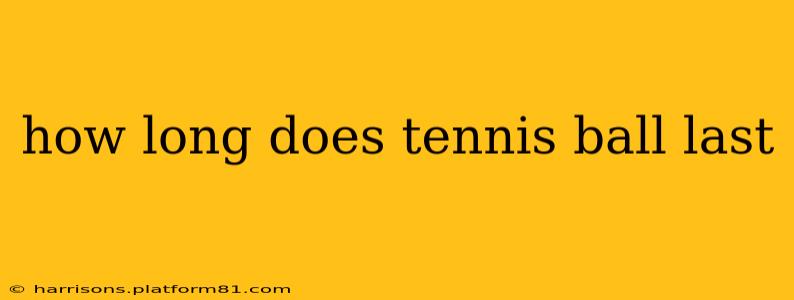Tennis balls, those seemingly simple yellow spheres, are crucial to the game. But how long do they actually last? The answer isn't a simple number of games or weeks; it depends on several factors. This guide will delve into the lifespan of a tennis ball, helping you understand when it's time to replace them and maximize your game.
What Affects a Tennis Ball's Lifespan?
Several factors influence how long your tennis balls remain playable. Understanding these will help you prolong their use and avoid frustrating gameplay caused by worn-out balls.
-
Playing Surface: Hard courts are the toughest on tennis balls, leading to quicker wear and tear than clay or grass courts. The abrasive nature of hard courts causes the felt to wear down more rapidly. Clay courts, with their slower pace, tend to preserve the ball's felt slightly longer. Grass courts, though gentler than hard courts, also see a significant impact on ball life.
-
Frequency and Intensity of Play: Daily intense matches will naturally wear down a tennis ball faster than occasional casual games. The more you hit the ball, the quicker the felt will wear and the pressure inside will decrease.
-
Environmental Conditions: Extreme heat can cause the pressure inside the ball to increase, while cold temperatures can make the pressure drop, affecting its bounce and overall performance. Humidity also impacts the ball's felt and internal pressure.
-
Storage: Proper storage is vital. Avoid leaving tennis balls in direct sunlight or extreme temperatures. Storing them in a cool, dry place helps to preserve their lifespan. Using airtight containers can also help to maintain the internal pressure.
-
Ball Quality: The quality of the tennis ball itself plays a significant role. Premium tennis balls, usually more expensive, typically last longer and maintain their performance characteristics for a longer duration than cheaper options.
How Many Games Can You Get Out of a Tennis Ball?
There's no magic number of games. Under ideal conditions (moderate play on a clay court, stored properly), a can of tennis balls might last for several matches. However, with frequent play on a hard court, a can might be significantly depleted after just one or two sets of intense play. Instead of focusing on games, watch for these signs:
When Should You Replace Your Tennis Balls?
Rather than counting games, focus on the ball's performance. Here are key indicators it's time for a new can:
-
Poor Bounce: If the ball's bounce becomes noticeably inconsistent or significantly lower than usual, it's time for a change. A consistently poor bounce disrupts gameplay and creates unfair advantages.
-
Fuzzy Felt: The felt covering starts to wear off, making the ball less aerodynamic and affecting its trajectory. A significant amount of fuzz loss directly impacts the spin and speed.
-
Changes in Flight: If the ball's trajectory is unpredictable or the spin is affected, it is a clear sign that the ball is worn out.
-
Loss of Pressure: A tennis ball that feels soft or under-inflated will significantly compromise the bounce and overall gameplay.
How Can I Prolong the Life of My Tennis Balls?
While you can't prevent wear and tear entirely, these tips can help prolong their lifespan:
-
Choose the Right Ball: Select balls appropriate for your playing surface.
-
Rotate Balls: During a match, use multiple balls to evenly distribute wear and tear.
-
Store Properly: Store them in a cool, dry place, away from direct sunlight.
-
Clean Them Regularly: Wipe off excess dirt and debris after each use.
People Also Ask (PAA) Questions:
How long do tennis balls last in a pressureless can?
Pressureless tennis balls generally last a bit longer than pressurized cans because the core doesn't lose its compression as quickly. However, they still lose their quality over time due to wear and tear of the felt, and ultimately need to be replaced.
Can I reuse tennis balls after they get wet?
While you can technically reuse wet tennis balls after they dry, their performance may be compromised. The wetness can damage the felt and affect the internal pressure, reducing their bounce and lifespan.
Are tennis balls good for dogs?
Tennis balls are a popular toy for many dogs. However, they can pose a few risks. The felt covering can be easily torn and swallowed, creating potential choking hazards. Always supervise your dog when they play with tennis balls and choose tennis balls specifically designed for dog play.
How do you tell if a tennis ball is bad?
Several signs indicate a bad tennis ball. Look for inconsistent bounce, significant wear on the felt, changes in flight pattern, or a soft, under-inflated feel.
By understanding these factors and paying attention to your balls' condition, you can optimize your tennis game and prolong the lifespan of your equipment. Remember, consistent performance relies on high-quality, well-maintained tennis balls.
